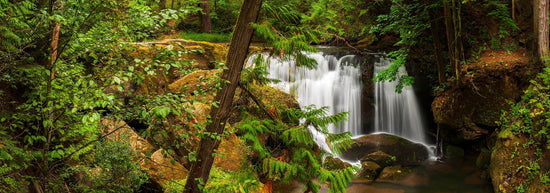In celebration of our partnership with Conservation Northwest for Timberwolf Premium Incense, please enjoy this interview with Wolf Program Lead Jay Shepherd, P.H.D.:
Conservation Northwest is thrilled to be partnering with Sea Witch Botanicals for their new Timberwolf scent. We appreciate their work to meaningfully support sustainability and the environment, so we wanted to share some background about gray wolves in the Northwest. Similar to other keystone species such as grizzly bears, fishers and Canada lynx, wolves are critical to the health of local ecosystems and essential for healthy populations of native species.
To learn more, Jay Shepherd, PH.D., Conservation Northwest’s Wolf Program Lead, shared some of his knowledge and experience working with Washington’s wolves. Dr. Shepherd is a wildlife biologist and lives in Chewelah in northeast Washington, managing our Range Rider Pilot Project, as well as helping administer the Northeast Washington Wolf-Cattle Collaborative, an independent, grassroots non-profit organization operating range riding and other year-round conflict avoidance tactics in northeast Washington.
Can you give an overview of the recent history (~100 years) of Washington’s wolves, and where we’re at today?
Gray wolves used to roam throughout the Pacific Northwest, and it’s believed one or more packs may have made their homes in every major river valley, down to the shores of the Puget Sound and the Pacific Ocean. They were and remain an integral part of the Northwest's ecosystems and cultural significance.
But by the 1930s, wolves were poisoned, trapped and shot to the extent that they were completely eradicated from Washington state, and no longer evident as a breeding population within the lower 48 states.
Through recovery efforts by the federal government in the 1990s in the central Idaho Wilderness Areas and Yellowstone National Park, in the 2000s the wolf population expanded from Wyoming, Idaho and Montana to the Pacific Northwest states of Oregon, Washington and even California. They have also come down from British Columbia, which has a robust wolf population. Having these two source populations for our state’s wolves -- one from coastal and interior BC and one from the northern Rocky Mountain states -- also supports genetic diversity within the population. Conservation and coexistence efforts by the Washington Department of Fish and Wildlife (WDFW) have been ongoing for over a decade.
Today wolves occupy a significant portion of available habitat in the Selkirk Mountains of northeastern Washington and the Blue Mountains of southeastern Washington. Wolves are making their way into the North and Central Cascades at a moderate pace. There are now approximately 25 known packs in the Blue and Selkirk Mountains and their foothills as well as four or five known packs in the Cascades. Wolves have been confirmed in the Marblemount and Baker Lake areas of eastern Skagit County, as well as on I-90 west of Snoqualmie Pass (and in the Teanaway and Cle Elum areas just east of the pass), but at present there are no confirmed wolf packs residing in Western Washington.

What do you think the future of wolf recovery will look like in Washington? How might wolves be affected by climate change and human populations?
Wolves are a contentious species, carrying the baggage of folklore, children’s story books, anthropomorphism, and persecution that has rarely been based on fact, science, or truth. Therefore, wolf recovery in the Western states has been controversial. This is the case in Washington as well, though the future looks brighter than the past.
Wolves will exist in Washington’s mountain ranges where their prey occurs and we will have a robust population. Wolves live throughout the world in a variety of climates from Iran and Israel to the Arctic. How climate change will affect wolves in Washington depends on how climate change will affect deer, elk and moose – their key sources of food. Warmer weather and more drastic fire seasons with more high intensity fires is changing the vegetation and reducing the habitat, food and hiding security for these prey species. We, as humans, can support increased populations of wolves’ prey by improving these species’ habitat through low-intensity prescribed (or planned) fire and not degrading prey habitat through excessive logging, high intensity human-caused fires or suburban development.
What habitat and prey do wolves need to thrive in the Northwest?
In the terms of habitat, wolves require that their prey have suitable habitat to thrive. This not only includes food, grass and shrubs, for their prey but also security and distance from human disturbance. Elk in particular thrive with less roads and human encroachment, but so do deer and moose. Yes, we see all these prey species near humans, on roads and in fields, out of necessity. For these populations to truly thrive, they need large secure areas away from roads, housing developments and open areas to hide their young and keep away from busy roads. These ungulates frequently require connected corridors of habitat between winter range in the lowlands and summer range in the high country, and thus so do wolves.
Wolves need the same, large wild areas as well as abundant populations of prey species. Though deer, elk and moose are somewhat wary of people due to the long arc of the history of persecution, wolves are generally extremely wary of people. They are more comfortable in areas with limited human interactions, like Yellowstone National Park, which is a great place to see wild wolves relax and be themselves.

Can you describe your work promoting coexistence between wolves and people in Washington?
I have been working for social tolerance in Washington, with a goal of coexistence between wolves and people, as well as between people and people, since 2009. I first worked for WDFW talking to ranchers and conservationists, getting to know how wolf-livestock and social conflicts occur and trying to figure out ways to reduce both. I now work for Conservation Northwest using those skills, but with the freedom to be more creative in developing coexistence strategies.
Conservation Northwest shares the cost of additional range riders with WDFW and ranchers so ranchers can hire more range riders, who are basically people on horse and/or ATV that create a human presence near and within livestock herds in remote wolf-occupied areas, an effective measure to deter wolves from preying on cattle. I founded the non-profit Northeast Washington Wolf-Livestock Collaborative that hired 20 new range riders over the last grazing season (May to November 2020), and we have successfully built trust with ranchers and deterred some of the worst wolf-livestock conflict in tough terrain.
What is your favorite memory throughout your work with wolves?
My favorite wolf memory is about a wolf with a GPS radio-collar near Ione (pronounced “eye-own”), Washington that was observed, by radio-collar location, to be scavenging on a dead cow at a ranch 20-30 miles to the west of the location where it was radio-collared. GPS radio-collar locations can be plotted on a computerized map in near-real time by satellite upload and download, so they can be observed from an office, miles away from the animal location, which allows for warm toes and coffee.
We went out and put up an electric fence to keep him away from the cow, since a wolf sticking around a ranch in February or March is likely to run into a young calf, an old cow, or people who, understandably, just may not want him around their cattle.
After three days of the wolf circling (persistence is a wolf trait) the fence and his precious dead cow, we ran him off. He travelled west into the Cascades and then kept going north, eventually ending up near Kleena Kleene, British Columbia, where he settled in an apparent pack territory for years. We were able to follow him for so long because the collar would keep uploading and downloading from anywhere, which it did for a few years. He was 475 air-miles from where he was originally radio-collared, which shows how incredibly far wolves can travel. This is Mr. Persistence before he went on his big walk-about.
Wolf Recovery in Washington
Conservation Northwest believes Washington can be the state where wolf recovery, conservation, and management work in the long run; for people, wolves and all the Northwest’s wildlife. Our organization is committed to the goal of long-term recovery and public acceptance of wolves alongside thriving local communities.
We believe conservationists, animal advocates, hunters, recreationists, ranchers, Native American nations and other wildlife stakeholders are best served by seeking common ground and working together towards win-win solutions. To collaborate in this manner requires recognizing and accepting the diverse values our wildlife and wildlands provide for all involved.
Find out more about wolf recovery in Washington and what Conservation Northwest is doing to support coexistence.





